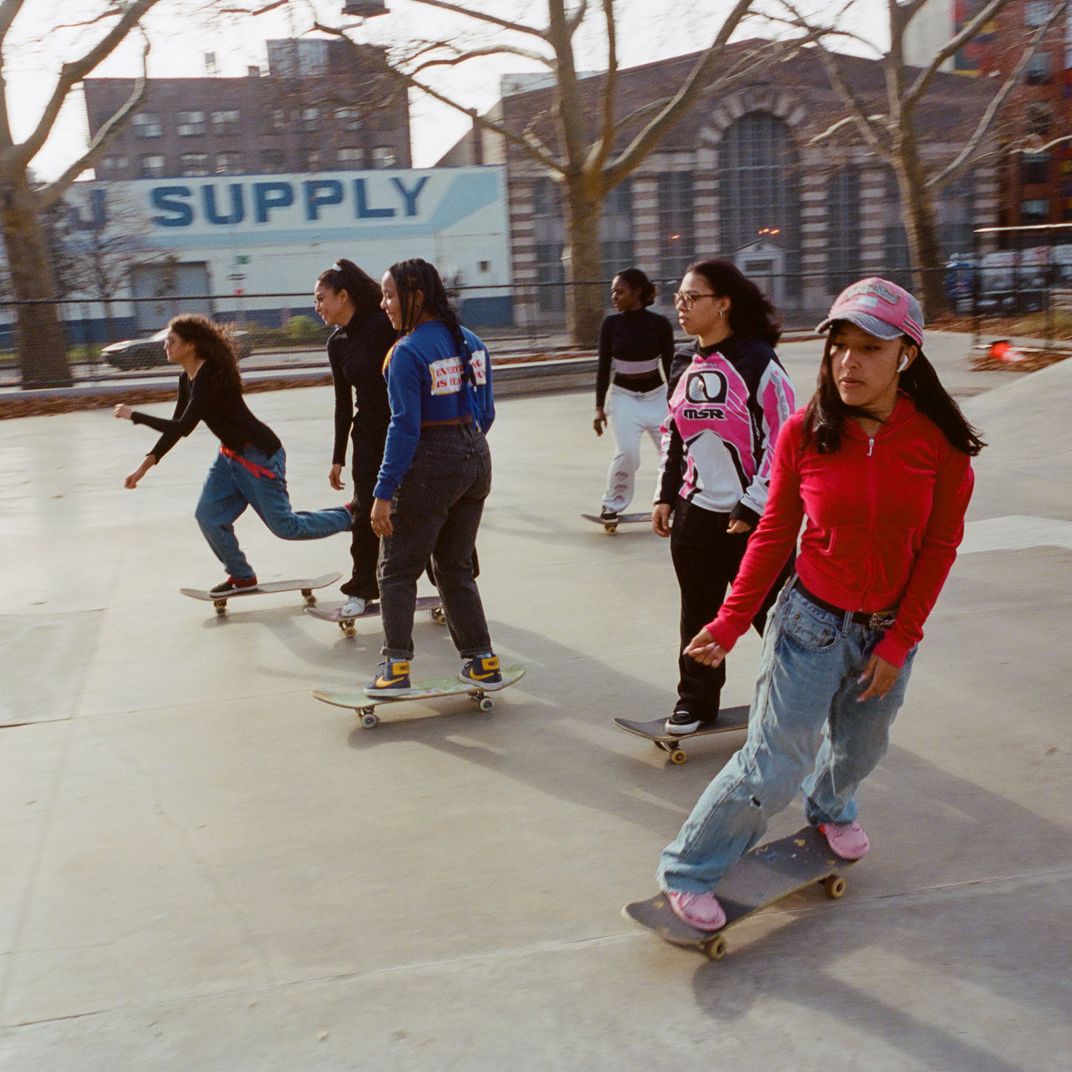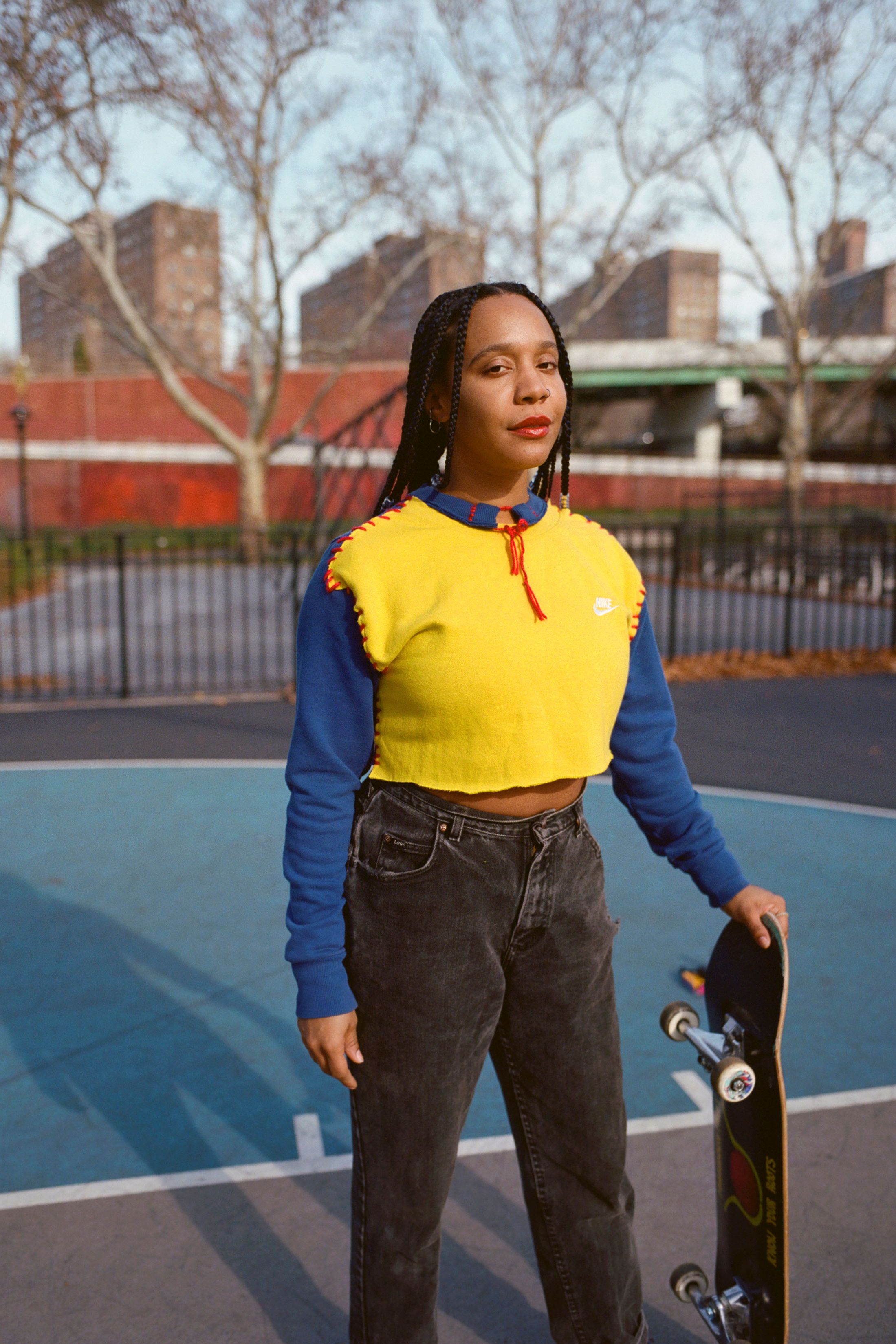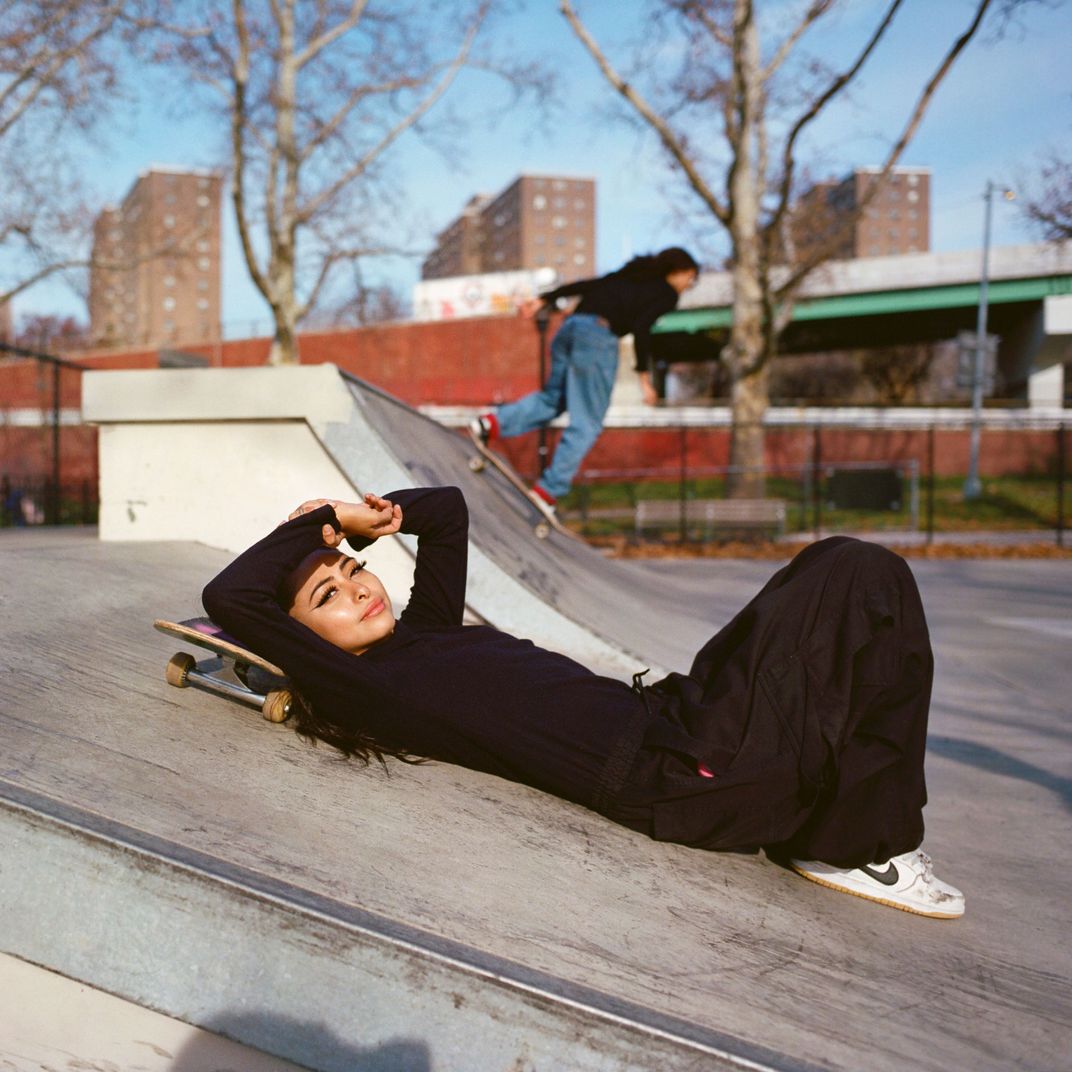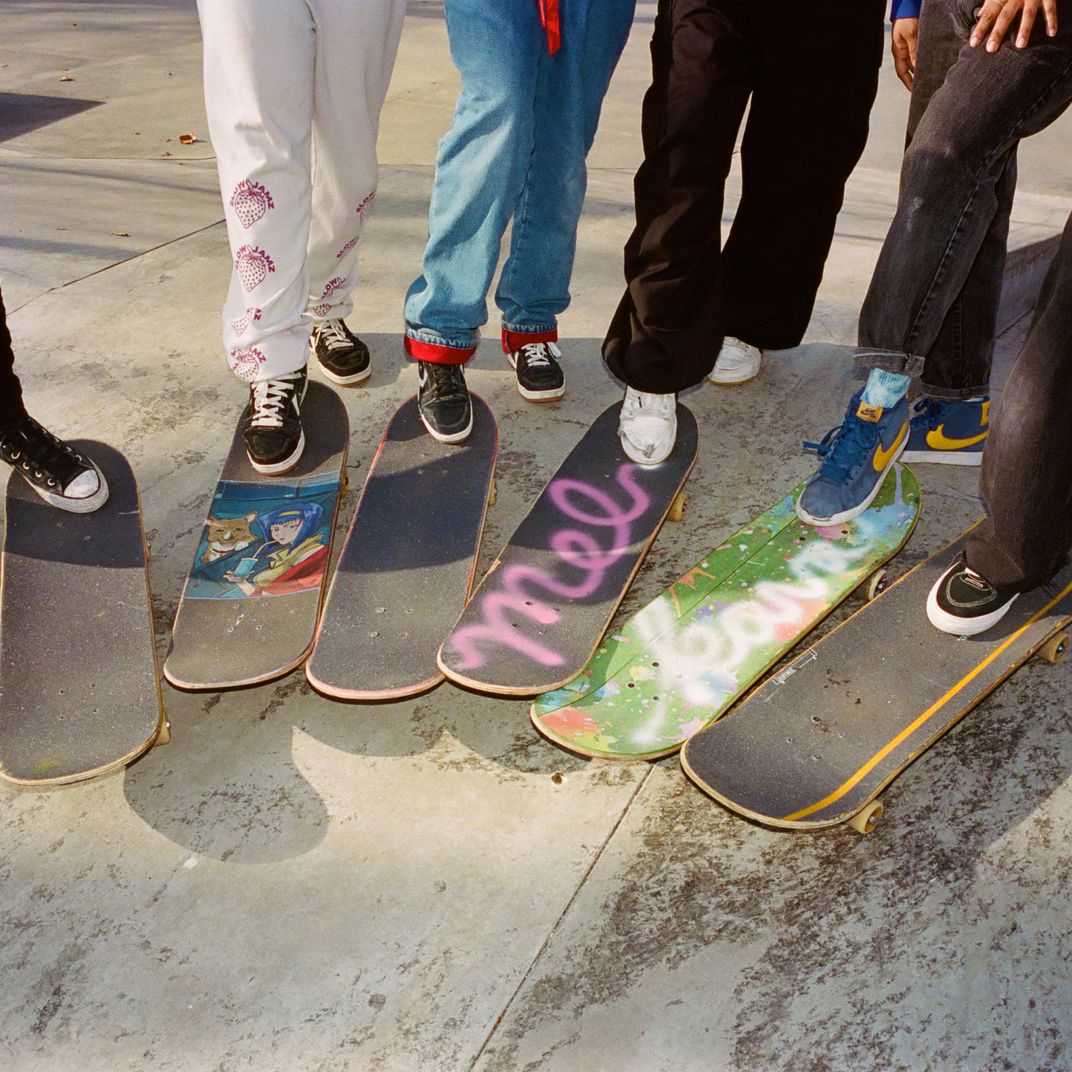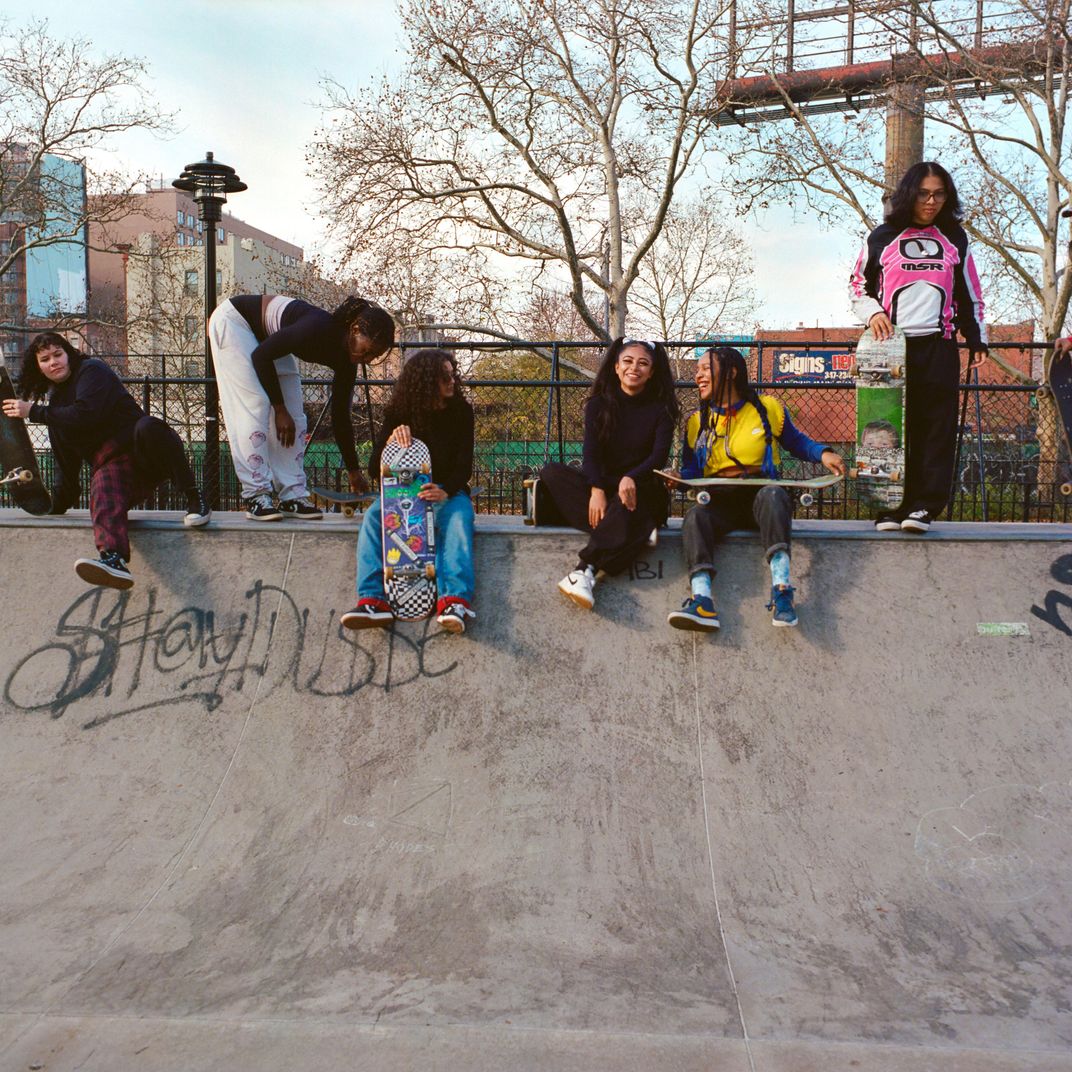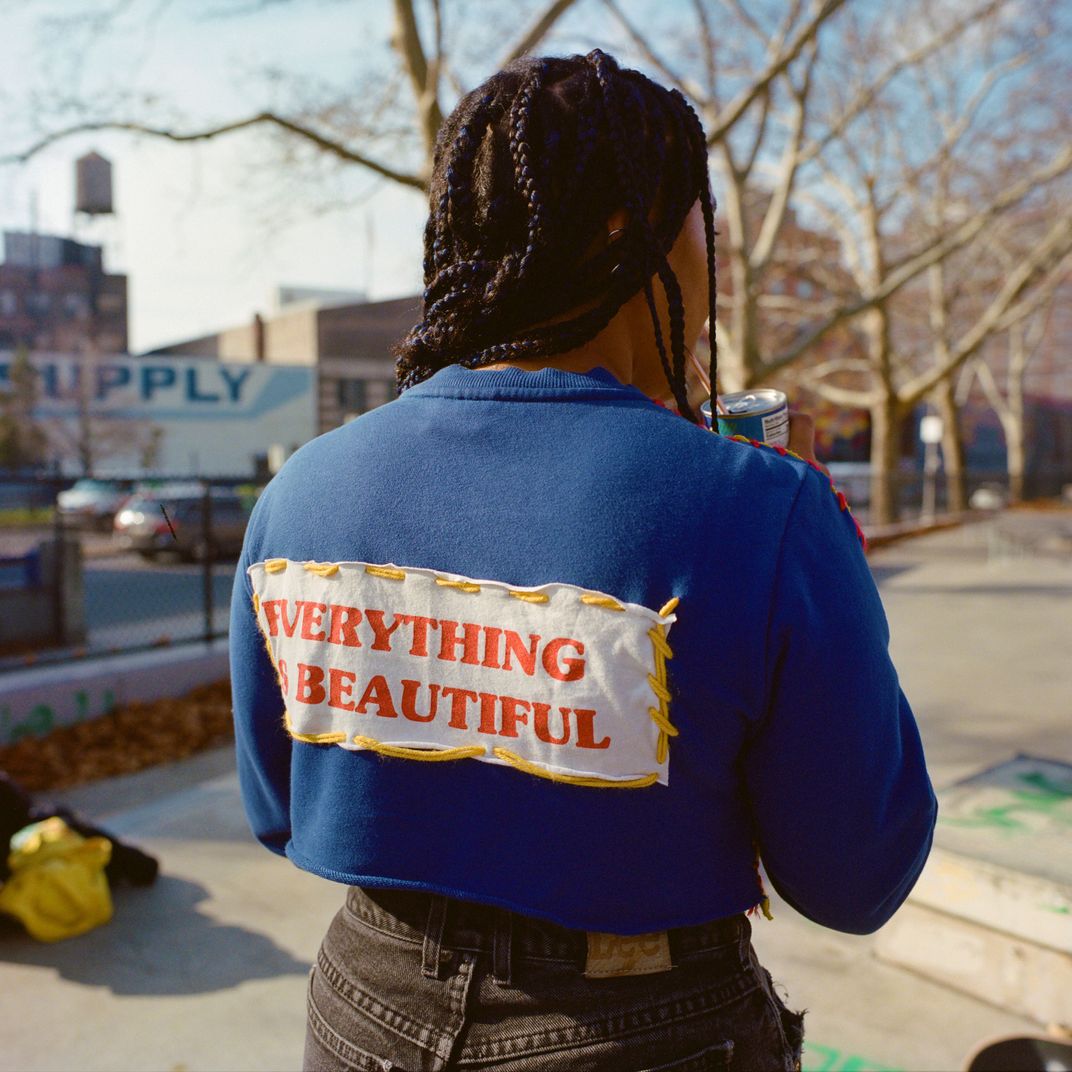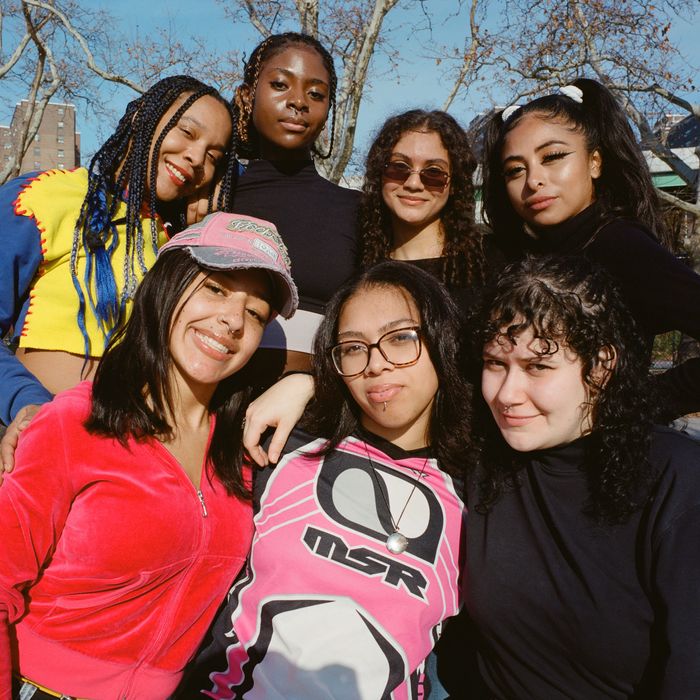
Before they met in 2020 via a flurry of Instagram DMs, skateboarders Kava Vasquez and Mel Ramirez were already in each other’s orbit, two planets circling the same concrete suns. Each had spent the majority of her life in the Bronx and, in recent years, started to skate it: tracing the contours of pavements and asphalt cracks, getting pummeled into scaffolding or splayed across stairs, glimpsing euphoria — or the closest thing to it — cruising the world on four urethane wheels.
“I remember seeing you for the first time and thinking, Oh wow,” Vasquez, 29, tells Ramirez, 26, during our Zoom call, her blue-dipped braids filling the frame. “I’d always been a tomboy and had this weird relationship with my femininity. I thought it was cool how you’d wear your sparkles in the park — it was refreshing to see someone unapologetically claim their womanhood in this space. I was like, man, she’s the only girl I’m consistently seeing here, and she’s got this squad of guys encouraging her.”
Vasquez knew back then, as Ramirez did, that while the city’s skate parks promised freedom, it was historically harder won for those on the fringes. So many of the guys who would zigzag freely across the park’s weathered obstacles, or fly in the streets beyond them, had been skateboarding from a very early age, being rewarded for their physical daring — and the scraped-up flesh that proved it. Vasquez recalls that even as a pretty tenacious, adventurous kid, much of her childhood was spent “being reminded that there’s a limit to what’s possible.” Girls weren’t shepherded toward skateboards in the same way boys were, often coming to it in their late teens or early 20s. (Even when Ramirez, a former Tae Kwon Do instructor, began skating five years ago, her mom yelled at her for “busting my butt” on a cruiser.) “There’s a lot of vulnerability when learning in public, when everyone around you has been socialized to underestimate you,” continues Vasquez. “And then we’re socialized to underestimate ourselves, especially physically. On top of that, the guys have been skating for so long that you feel you’ll never catch up.”
When Vasquez finally reached out to Ramirez after repeatedly crossing paths, it was with a business proposition. She wanted to be friends but also to build a local collective together, a nonjudgmental community where femme and queer skaters might meet friends and hone their skills together. Ramirez, it turned out, had flirted with a similar idea. “It’s funny, but I’d never thought of having someone else to start this with,” she says. “I realized it would be nice to have someone as strong as Kava to help.”
The following photographs, taken by Avery Norman in late 2023, document Bronx Girl Skate founders Ramirez and Vasquez along with a handful of their teammates at Playground 134. Their collective currently sponsors about ten athletes, hosts an annual anniversary party and a Summer Skate Jam, and runs inclusive grassroots skate events with brands like Nike SB and Bones Bearings. Later this year, they will record and release the organization’s debut skate video. “For girls coming in now,” says Vasquez, “I think groups like us, Sk8Babes, Environmental Hood Restoration, and PANSY, plus the Harold Hunter Foundation, are all finding different ways within New York’s skating ecosystem to make it more welcoming to people of different backgrounds. For us, that landscape didn’t exist until we created it.”
“Knowing how to fall is important,” says Trinity Degracia, one of the team’s youngest members. “If you don’t commit to a trick — let’s say an ollie down a five-stair — if you bail out, falling straight on your wrist, knees, or ankle, you risk breaking those bones, twisting or spraining them. You won’t be able to skate for God knows how long. You must know how to distribute your weight or be able to catch yourself when you fall.”
“Having participated in skate-park builds, I’ve learned that I love building. The team is almost always people of different backgrounds, languages, ethnicities, and religions,” says Vasquez.
“I remember our first event and how scared I was,” says Ramirez. “I thought no one would come. When a lot of girls showed up, my heart melted.” This year, BXGS will sponsor their team to compete at Skate Like a Girl’s Wheels of Fortune weekend, the longest-running showcase of female-identifying, trans, and gender-nonconforming athletes globally. “Skateboarding keeps me at peace,” Ramirez continues. “It’s what makes me feel free. I’d love us to organize things outside of skateboarding, too, like educational courses.”
Degracia began skating when COVID first descended on New York. “I was almost finished my first year of high school. I didn’t grow up skating, but my mom took me snowboarding when I was younger, and I had a great time,” she says. “I was immediately sold when I learned my dad had been a skilled skateboarder at my age. I told him that I wanted to learn, and he got me my first board two days later.”
Photographer Norman observed a certain sweetness among the skaters. “They had a strong sense of community and care for each other,” she says. “They wanted to spotlight each other’s tricks and talents.”
Skating can be a year-round pleasure for the collective. “I love when I can surf and skate in the same day,” says Vasquez, “going to Rockaway Beach Skate Park and you’re salty and you can smell ocean air. It’s like a warm caress on your cheeks as you slam and get back up. Then in fall, you can shed some layers, there’s the traces of summer breeze, but it smells like a campfire outside. Skating feels more meditative in fall.”
Vasquez wears a DIY shirt.
“Knowing how to fall is important,” says Trinity Degracia, one of the team’s youngest members. “If you don’t commit to a trick — let’s say an ollie down a five-stair — if you bail out, falling straight on your wrist, knees, or ankle, you risk breaking those bones, twisting or spraining them. You won’t be able to skate for God knows how long. You must know how to distribute your weight or be able to catch yourself when you fall.”
“Having participated in skate-park builds, I’ve learned that I love building. The team is almost always people of different backgrounds, languages, ethnicities, and religions,” says Vasquez.
“I remember our first event and how scared I was,” says Ramirez. “I thought no one would come. When a lot of girls showed up, my heart melted.” This year, BXGS will sponsor their team to compete at Skate Like a Girl’s Wheels of Fortune weekend, the longest-running showcase of female-identifying, trans, and gender-nonconforming athletes globally. “Skateboarding keeps me at peace,” Ramirez continues. “It’s what makes me feel free. I’d love us to organize things outside of skateboarding, too, like educational courses.”
Degracia began skating when COVID first descended on New York. “I was almost finished my first year of high school. I didn’t grow up skating, but my mom took me snowboarding when I was younger, and I had a great time,” she says. “I was immediately sold when I learned my dad had been a skilled skateboarder at my age. I told him that I wanted to learn, and he got me my first board two days later.”
Photographer Norman observed a certain sweetness among the skaters. “They had a strong sense of community and care for each other,” she says. “They wanted to spotlight each other’s tricks and talents.”
Skating can be a year-round pleasure for the collective. “I love when I can surf and skate in the same day,” says Vasquez, “going to Rockaway Beach Skate Park and you’re salty and you can smell ocean air. It’s like a warm caress on your cheeks as you slam and get back up. Then in fall, you can shed some layers, there’s the traces of summer breeze, but it smells like a campfire outside. Skating feels more meditative in fall.”
Vasquez wears a DIY shirt.
Elisha Gelin, a BXGS member based in Yonkers, found herself gravitating toward Vasquez and Ramirez even before they founded the collective. “We’d often skate at the same parks. We found comfort in each other,” Gelin says.
Now 27, Gelin got on her first board at 19 years old, when her best friend, Larissa De Oliveira — also a BXGS athlete — loaned her a spare while they were visiting a friend in Pennsylvania. “When I started skateboarding in the Bronx, it was a male-dominated sport. I was often the only girl at the park if I didn’t intentionally plan to go with a group of friends,” she says. “Further, the men weren’t particularly supportive of female skaters. I often felt judged, like I didn’t belong there or as if I was taking up someone else’s space by just existing in the park.” Over the past few years, Gelin has noticed a shift in this dynamic. She thinks it’s due in part to groups like BXGS, which crack open street corners and whole parks, making shared spaces less isolating and more alive.
Skateboarding’s acolytes have long collided with urban planning and social justice, reshaping neighborhoods so people can better soar inside them. The BXGS founders follow in this tradition: Both are deeply embedded in their community, developing resourcing for underfunded, underrepresented skateboarders in the Bronx and beyond. Last February, Vasquez worked with Christopher Ricardo Blandino to co-produce Caras Del Skate Festival in the Dominican Republic. Ramirez, who is Mexican American, visits Puerto Rico often to support her boyfriend, Nicholas Ramos, at Manny Santiago’s annual skate contest, Prince of Puerto Rico. “We’re grateful for the opportunities and resources we get,” says Vasquez, “whether it’s to feed people or give products to kids whose boards are chewed up at the park. Empowering the most marginalized people ultimately uplifts the whole.”
Correction: A previous version of this story incorrectly stated that the site where the collective gathers was called Playground 137, and that the acronym for the collective was “BGS.”


